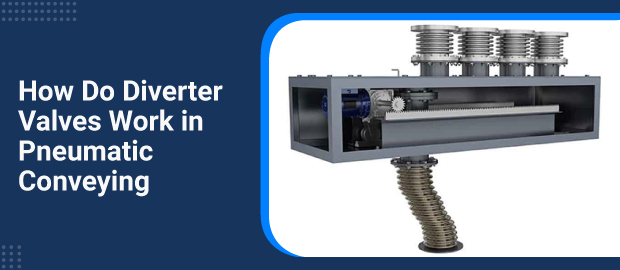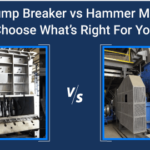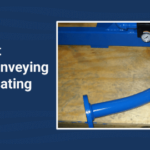Diverter valves, as the name suggests, are used to divert the multiple pickup points when used in a pneumatic conveying system. With the use of this hardware, the materials are directed continuously, hygienically, and smoothly.
The pneumatic conveying diverter valves have varying operations depending on the design of the hardware. A typical multi-outlet diverter valve for pneumatic conveyors consists of an oscillating tube, limit switch, electric valves, and inflatable seal as the major components.
But, there is a lot to learn about the working and design of the diverter valves being used in pneumatic conveying applications. So, read along this article till the end to be aware of the functionalities associated with diverter valves.
Look out for the practical and productive benefits of adopting Macawber’s diverter valves for your diverse pneumatic conveying applications.
A] What is the Significance of Diverter Valve?
For all the new key players in the industry, diverter valves might not be initially a necessity for your pneumatic conveying needs, but you might come across the need for it later. But, you must get an idea of what a diverter valve is right from the starting phase to be able to analyse its necessity in the long run.
The diverter valves, when connected to the pneumatic conveying systems, will be used to direct various materials to diverse receiving spots. Or could also be used to connect multiple pickup points to a common destination. In contrast to that, these valves can also be connected to deliver products from multiple belts to one destination.
The purpose of its integration into pneumatic conveying machines is to ensure a smooth and consistent flow of the materials, which will minimise clogging, pressure drops, and product contamination. Diverter valves are available in diverse designs, ideal for a range of pneumatic conveying systems.
Irrespective of whether your pneumatic conveyor is indoors or outdoors, these valves can be used in them all! Keep reading along to learn more about the working operations of the diverter valves!
B] How Do the Diverter Valves Work in Pneumatic Conveying Systems?
For your information, the diverter valves will be installed alongside the conveying line. The four components are responsible for deriving how the diverter valve works. The component-wise working of the pneumatic conveying systems is stated as follows:
- The oscillating tube will first be fitted onto your diverter, which will allow the valve to move in literally any position or direction automatically.
- The limit switch will ensure that the positioning of the oscillating tube is as expected.
- Electric valves are meant to control the overall movement of the oscillating tube. A manometer will be used to indicate and measure the pressure.
- An inflatable seal will be placed over the head of the oscillating tube, which will serve the purpose of providing a strong seal between the outer fixed ends and the inner rotating pipe.
C] What are the Diverse Applications of Diverter Valves?
In the industrial setup, the diverter valves serve several applications in pneumatic conveying because of the smooth and hygienic passage of materials from one spot to another. For instance, the waves are useful mostly for supporting the pneumatic conveying of beverages and food, as product retention is avoided.
Due to the use of diverter valves, hygienic transportation will be ensured, which will overcome the food contamination risk. Not only that but the diverter valves can also be used for dense phase systems, making the conveyor ideal for transporting abrasive and fragile materials.
When you have a tight seal over the oscillating tubes, your pneumatic conveying system diverter valves will be able to transport materials that are easily contaminated or get clogged. As the initial purpose of the diverter valves is to direct the flow of material to diverse outlets or vice versa, it is an important integration in industrial facilities where there are multiple pick-up or drop points.
D] What are the Varying Diverter Valve Types?
In an industrial setup, you can use a diverse range of diverter valves designed to be compatible with varying pneumatic conveying systems and the required applications. But, for your knowledge, some of the common diverter valves that are mostly used by the industrial key players are.
- Rotary Tube Selector Valve
These diverter valves for pneumatic conveying systems are meant mostly for the dense phase, dilute phase, or vacuum type machines, ideal for directing the material flow to not one but diverse locations. You can prefer using rotary tube selector valves for high-pressure applications, where you might need to transport abrasive or fragile powders.
- Rotating Pipes
The Rotating pipe design works on similar lines as that of the rotary tube design with differences in overall construction. These diverters are also used in high-pressure applications, where you might need to transport abrasive or fragile powders.
- Drum Diverters
Drum diverter valves, better known as rotating plug diverters, are among the best options to serve hygienic applications. It is mostly because the design of this valve offers you a tight seal, which will prevent all types of product retention.
- Y-Type Diverter Valves
Y-type or DV-type diverter valves are ideal for both dilute and vacuum conveying systems. These are ideal for transporting abrasive materials and can be custom designed for heavy duty usage. The only drawback is the dead plug of material that can build up in the Y-piece.
E] Things to Consider Before Buying the Right Diverter Valves
So far in the article, you are already aware of the different types of diverter valves available to meet your varying operational needs. But, it might still be immensely challenging when it comes to choosing the ideal type for your specific pneumatic conveying requirements. To help you in the quest of choosing the perfect ideal pneumatic conveying system for your select applications, here are some consideration factors for you to count on:
1. Costing Considerations
The first thing you must count on while choosing your diverter valve is the cost of the initial setup. But, alongside the initial cost, you must also take note of the long-term expenses as well.
For that, you must compare the purchase price against the installation expense, estimated maintenance cost, and other such costing factors. For instance, if you are buying a diverter valve that is cheaper but comes with poor sealing, you will have to bear losses due to product contamination or leakage.
2. Type of System
You must be very strict about choosing a diverter valve that goes well with your pneumatic conveying system. It is because, without proper design alignment of the valves to that of the pneumatic conveying systems, application efficiency will deteriorate.
For instance, the diverter valves meant for the dilute phase conveying systems might not be ideal for use with the dense phase counterparts. So, do assess the compatibility factor before making the purchase.
3. Conveying Material
Next, you must determine the type of materials you will be conveying through the pneumatic systems before you decide on the right type of diverter valve for the purpose. Certain diverter valves are excellent for the transfer of abrasive or frangible materials, while some might only be designed for non-abrasive liquids or powders.
You must take note of the characteristics of the materials that you are about to transport through the conveying systems, depending on which design you can choose that will successfully protect or handle the product.
4. Overall Design
You need to get an idea of the materials or components used in the making of a director valve for your pneumatic conveying system. There are different materials, such as cast iron, aluminium, speciality alloy, or stainless steel, which are used in making the director valves.
You should make the choice depending on what your transportable material demands. Following that, you must also take note of the system specifications or power availability for choosing the right actuators, whether air, manual, or electric motor options.
Look out for the practical and productive benefits of adopting Macawber’s diverter valves for your diverse pneumatic conveying applications.
Conclusion
With this, you now have an in-depth knowledge of how the diverter valves work and what you must consider before getting one. Your pneumatic conveying systems can be advanced with their functionalities by using a diverter valve. So, it becomes really very important for you to emphasise selecting the right one for the job.
But, even though you have a general understanding of the function and efficacies of various diverter valves, you might still face the dilemma of what could be best for your specific needs. In that case, Macawber, the best pneumatic conveyor manufacturer, is here to help you select the right diverter valves with respect to your pneumatic conveying systems.
We have the best-quality diverter valves to suit all your needs and compatibility requirements. Apart from expert suggestions, we can also provide you with the right quality hardware and quick installations to ensure your production works don’t get halted at all. Connect with us today to learn more about our pneumatic conveying diverter valves.



